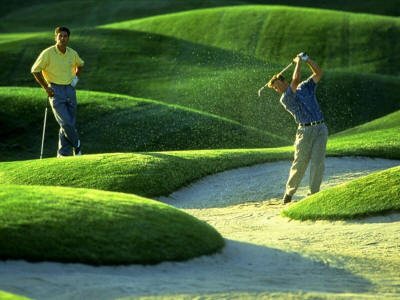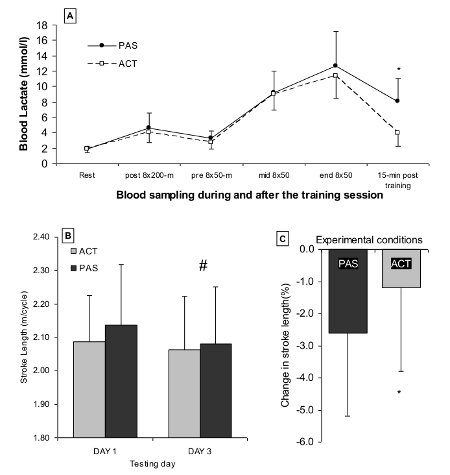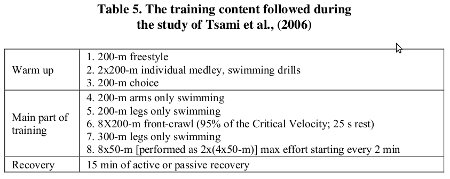Performance in individual sports
 During a laboratory setting, it is possible to control the load applied on the subjects. A controlled high intensity cycling protocol was applied by Lane and Wenger (2004) to examine the effects of several types of recovery on performance 24 hours later. Ten active males performed a series of 22 sprints ranging in duration from 5 to 15 s all applied with a work to rest interval 1:5.
During a laboratory setting, it is possible to control the load applied on the subjects. A controlled high intensity cycling protocol was applied by Lane and Wenger (2004) to examine the effects of several types of recovery on performance 24 hours later. Ten active males performed a series of 22 sprints ranging in duration from 5 to 15 s all applied with a work to rest interval 1:5.
Following this high intensity session, the participants followed a 15-min massage, cold water immersion, active recovery at an intensity of 30% of VO2max and passive recovery on four experimental conditions. Performance measured in the same 22 sprints 24 hours later was maintained in all recovery conditions (massage, cold water immersion, active recover) but was reduced after passive recovery (Lane and Wenger 2004).
Figure 5. Blood lactate changes (panel A) during the training session followed either by passive or active recovery. Changes in stroke length (panel B) and percentage changes in stroke length (panel C) the days before (DAY 1) and the day after (DAY 3) the training session. * indicate p<0.05 between ACT and PAS conditions, # indicate differences between DAY 1 and DAY 3. (Data from Tsami et al., 2006; Reproduced with permission)
Table 5. The training content followed during the study of Tsami et al., (2006)
Table 6. The effects of active recovery applied after a training session or competition on performance during the following session or the following day

MP: mean power, CMJ: countermovement jump, VJ: vertical jump, SJ: squat jump, BJ: bounch jump, SL: stroke length, F: female, M: male, AR: active recovery, PR: passive recovery, NS: no significant difference after active or passive recvery.
In addition to cycling, swimming training intensity can be precisely controlled in the field (swimming pool). The effects of active or passive recovery were studied after a high intensity training session in young swimmers (Tsami et al., 2006). The swimmers completed a training session including high intensity aerobic and anaerobic contents (see Table 5). The day before training and the day after training, swimmers performed a 50-m maximal and a 400-m sumbaximal (85% of the best time) test for the evaluation of metabolic and temporal parameters (stroke rate and stroke length). Fifteen minutes of active recovery at a pace corresponding to 60% of the 100-m velocity were applied immediately after the training session and helped to maintain a higher stroke length compared to passive recovery on the 400-m sub-maximal test but had no effects on the maximum intensity 50-m sprint time the day after training (Figure 5; Tsami et al., 2006). The results from studies in individual sports are not conclusive but support the use of a 15-min low intensity active recovery following a training session. A summary of studies using active recovery after a training session or competition are shown in Table 6.



